
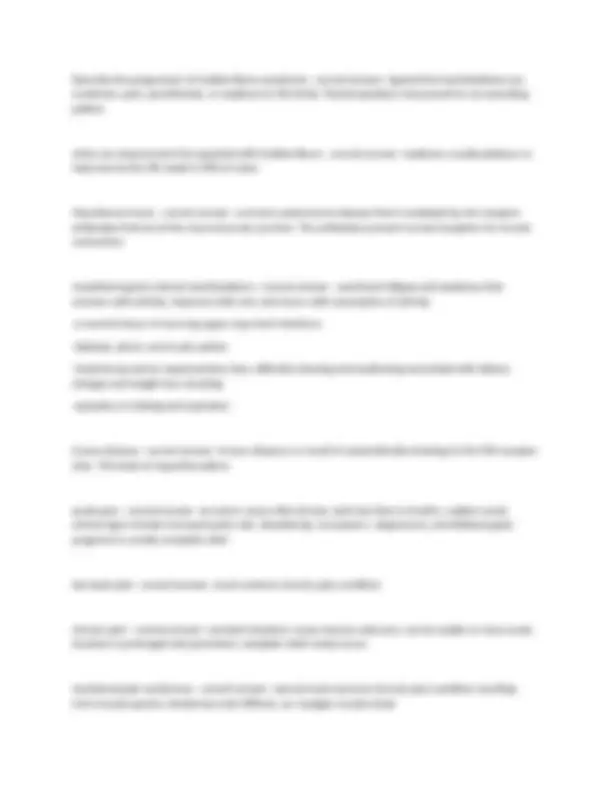
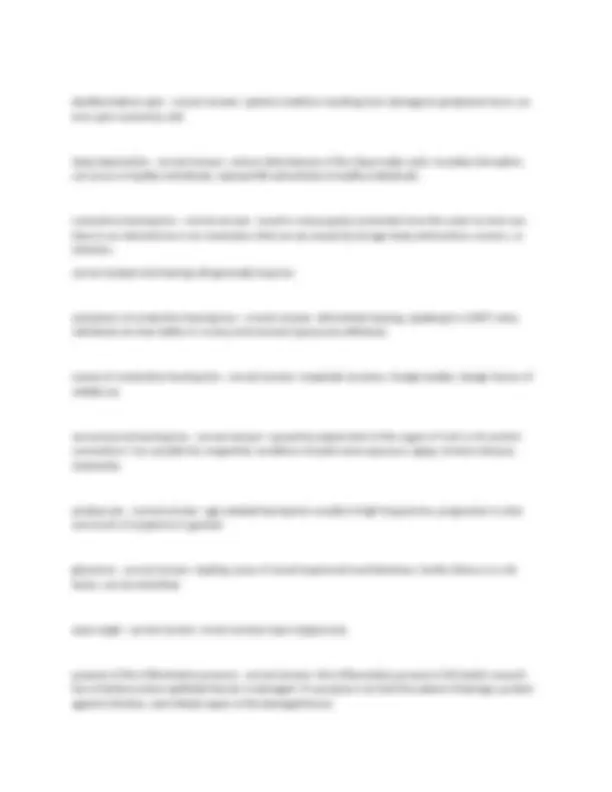
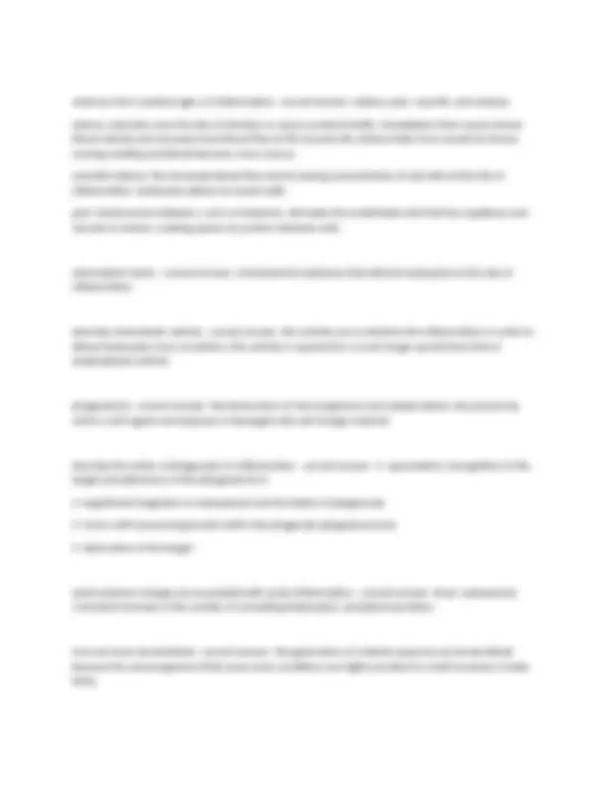
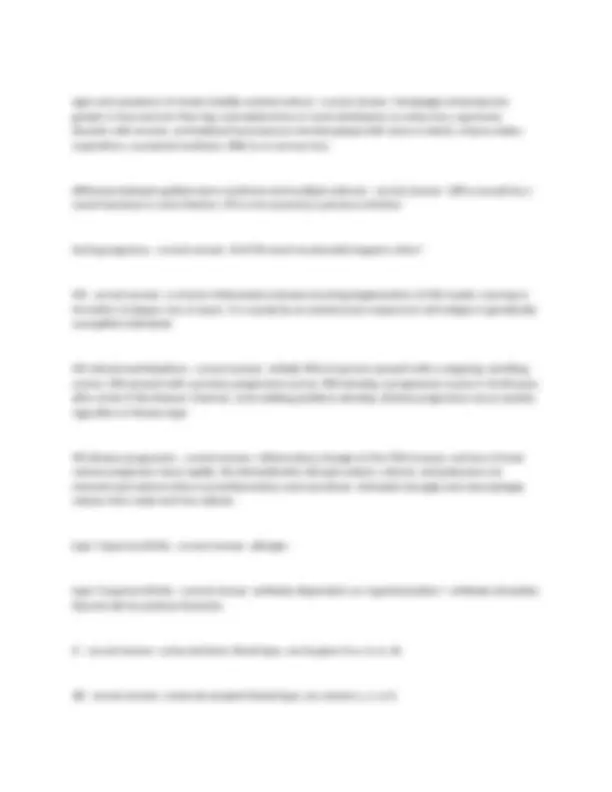
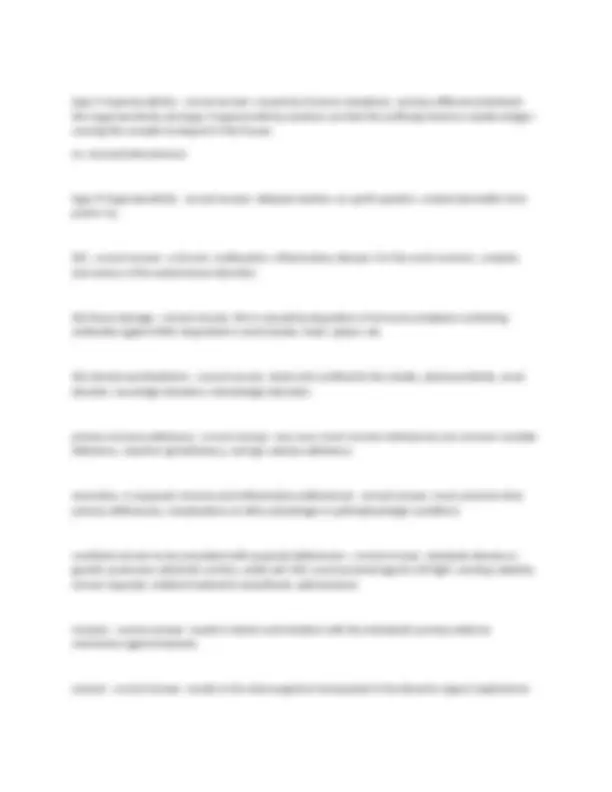
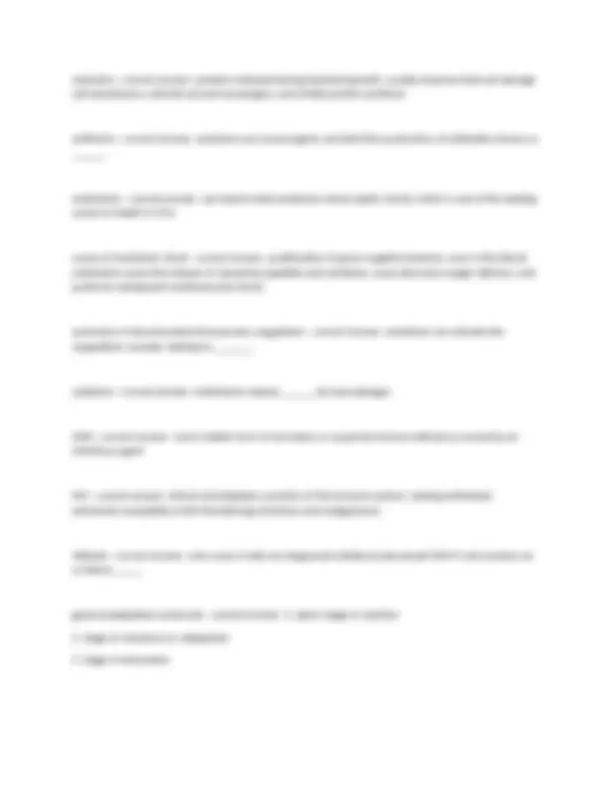
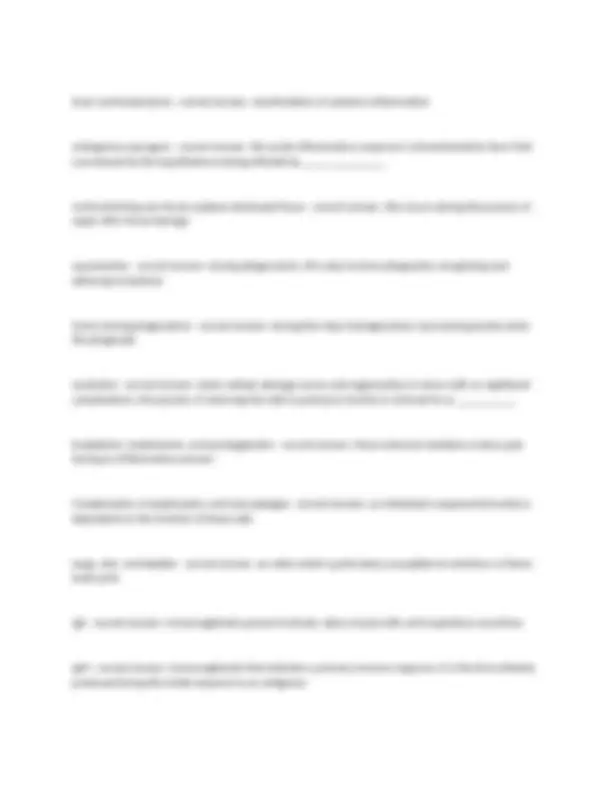
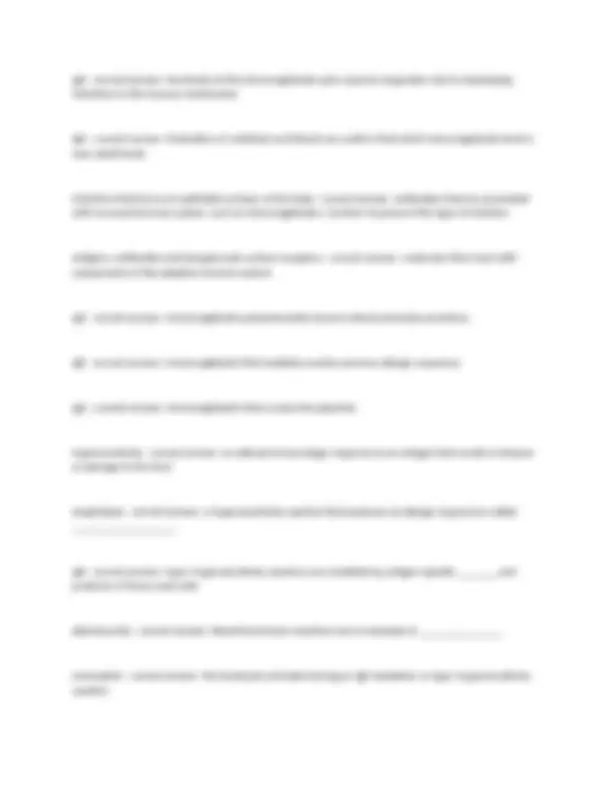
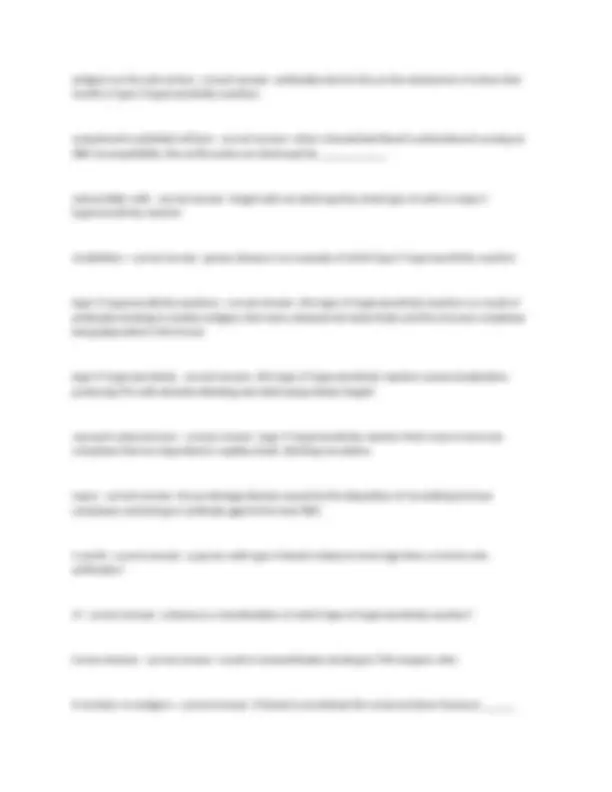
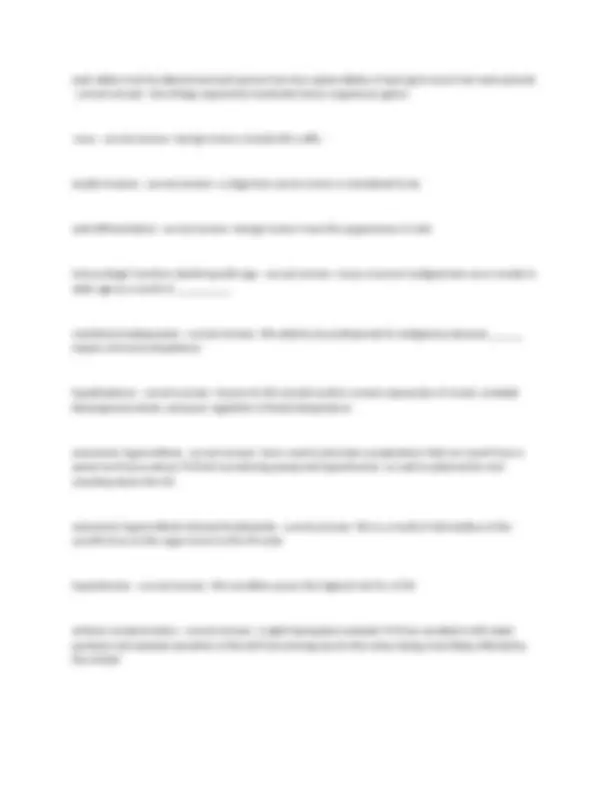
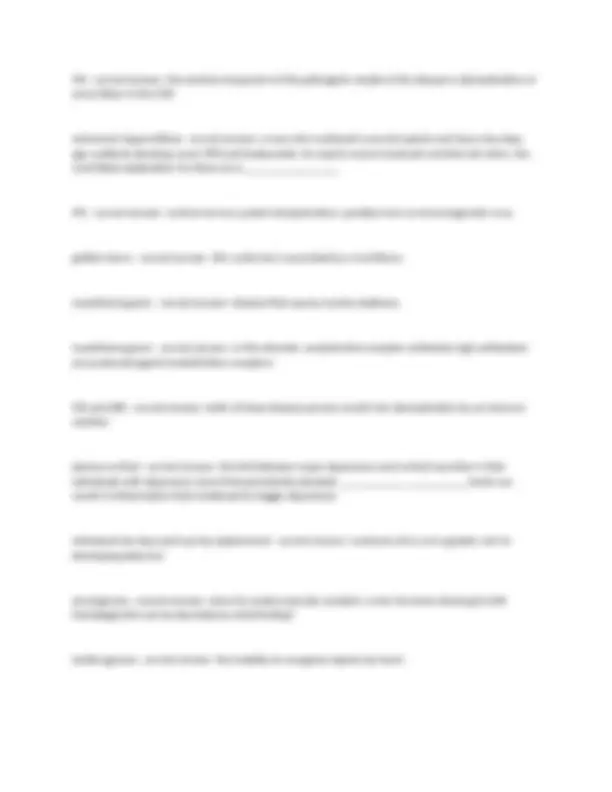



Study with the several resources on Docsity

Earn points by helping other students or get them with a premium plan


Prepare for your exams
Study with the several resources on Docsity

Earn points to download
Earn points by helping other students or get them with a premium plan
Community
Ask the community for help and clear up your study doubts
Discover the best universities in your country according to Docsity users
Free resources
Download our free guides on studying techniques, anxiety management strategies, and thesis advice from Docsity tutors
A comprehensive exam covering a wide range of medical concepts and topics. It includes questions and correct answers on various body systems, nervous system functions, inflammation, hypersensitivity reactions, blood types, immune deficiencies, bacterial infections, stress response, tumor characteristics, and more. The level of detail and breadth of topics suggests this could be a valuable resource for medical students, nursing students, or other healthcare professionals preparing for exams or seeking a thorough review of these fundamental medical principles. A structured format with clear, concise explanations of the correct answers, making it potentially useful as study notes, lecture materials, or a summary of key concepts in these areas of medicine.
Typology: Exams
1 / 20

This page cannot be seen from the preview
Don't miss anything!













Which body system is responsible for conserving energy and body resources - correct answer - Parasympathetic nervous system which system responds to stress by preparing the body to defend itself - correct answer -Sympathetic nervous system (SNS) how is blood flow redistributed by the sympathetic nervous system (SNS) - correct answer -blood flow to the muscles is increased while blood flow to GI and integumentary is decreased how are primary brain injuries classified - correct answer -focal or diffuse (aka multifocal) focal brain injuries - correct answer -specific, grossly observable brain lesions that occur in a precise location Epidural and subdural hemorrhages diffuse brain injuries - correct answer -include brain injury due to hypoxia, meningitis, encephalitis, and damage to blood vessels The brain is confined in a limited space so increased pressure can cause collateral dysfunction: Diabetes Insipidus (ADH not secreted thus polyuria) autonomic hyperreflexia - correct answer -affected at the t5-t6 level or above; characterized by paroxysmal HTN (up to 300 mmHg systolic), a pounding headache, blurred vision, sweating above the level of the lesion with flushing of the skin, nasal congestion, nausea, piloerection caused by pilomotor spasm, and bradycardia (30-40 beats/min) location of lesions in cases of autonomic hyperreflexia - correct answer -individual most likely to be affected have lesions at the T5-T6 level or above
sequence of events that lead to hyperreflexia induced bradycardia - correct answer -bradycardia (30- 40bpm) is a sx of hyperreflexia Stimulation of the carotid sinus -->vagus nerve -->sinoatrial (SA) node. The intact ANS reflexively responds with an arteriolar spasm that increases blood pressure. Baroreceptors in the cerebral vessels, the carotid sinus, and the aorta sense the HTN and stimulate the PNS. The heart rate decreases, but the visceral and peripheral vessels do not dilate because efferent impulses cannot pass through the cord Alzheimer's disease - correct answer -leading cause of dementia and one of the most common causes of severe cognitive dysfunction in older adults what are the greatest risk factors for Alzheimer's disease - correct answer -age, family history what are the proposed protective factors for Alzheimer's disease - correct answer -low calorie diets, estrogen replacement at time of menopause, NSAIDs, physical activity, antioxidants, the presence of apoE what genetic susceptibility tests are used to screen for early-onset AD - correct answer -PSEN 1 (presenilin) on chromosome 14, PSEN 2, and APP (amyloid precursor protein) on chromosome 21 When can a specific diagnosis of AD be given - correct answer -postmortem examination what is the single greatest risk factor for stroke - correct answer -hypertension (87% of occurrences) what are common risk factors for stroke - correct answer -arterial HTN, insulin resistance and DM, elevated cholesterol or low high density lipoprotein (HDL), elevated lipoprotein- A level, hyperhomocysteinemia, congestive heart disease and PVD, asymptomatic carotid stenosis, polycythemia and thrombocythemia, a-fib, postmenopausal hormone therapy, high sodium intake above 2300mg, low potassium intake less than 4700mg, smoking, lack of physical activity, obesity, chronic sleep deprivation which autoimmune disease typically presents 2-4 weeks following a bacterial/viral infection such as respiratory or GI illness (ex: flu) - correct answer -Guillain-Barre syndrome
deafferentation pain - correct answer -painful condition resulting from damage to peripheral nerve; ex: burn pain caused by cold sleep deprivation - correct answer -serious disturbances of the sleep-wake cycle; circadian disruption; can occur in healthy individuals; reduced NK cell activity in healthy individuals conductive hearing loss - correct answer -sound is not properly conducted from the outer to inner ear. there is an interference in air conduction that can be caused by foreign body obstructions, tumors, or infection. can be treated and hearing will generally improve symptoms of conductive hearing loss - correct answer -diminished hearing, speaking in a SOFT voice, individual can hear better in a noisy environment (paracusia willisiana) causes of conductive hearing loss - correct answer -impacted cerumen, foreign bodies, benign tumor of middle ear sensorineural hearing loss - correct answer -caused by impairment of the organ of Corti or its central connections. Can possibly be congenital; conditions include noise exposure, aging, meniere disease, ototoxicity presbycusis - correct answer -age-related hearing loss usually in high frequencies. progression is slow and onset of symptoms is gradual glaucoma - correct answer -leading cause of visual impairment and blindness; family history is a risk factor, can be inheritied open angle - correct answer -most common type of glaucoma purpose of the inflammatory process - correct answer -the inflammatory process is the body's second line of defense when epithelial barrier is damaged. It's purpose is to limit the extent of damage, protect against infection, and initiate repair of the damaged tissue
what are the 4 cardinal signs of inflammation - correct answer -edema, pain, warmth, and redness edema: arterioles near the site of infection or injury constrict briefly. Vasodilation then causes slower blood velocity and increases local blood flow to the injured site. plasma leaks from vessels to tissues causing swelling and blood becomes more viscous warmth/redness: the increased blood flow and increasing concentration of red cells at the site of inflammation. leukocytes adhere to vessel walls pain: biochemical mediators, such as histamine, stimulate the endothelial cells that line capillaries and venules to retract, creating spaces at junction between cells chemotactic factor - correct answer -a biochemical substance that attracts leukocytes to the site of inflammation describe chemotactic activity - correct answer -this activity occurs distal to the inflammation in order to attract leukocytes from circulation. this activity is required for a much longer period than that of anaphylatoxic activity phagocytosis - correct answer -the destruction of microorganisms and cellular debris; the process by which a cell ingests and disposes of damaged cells and foreign material describe the action of phagocytes in inflammation - correct answer -1. opsonization (recognition of the target and adherence of the phagocyte to it
IgG - correct answer -the most abundant class of innumoglobulins; they constitute 80-85% and account for the most protective activity against infections Maternal IgG crosses into placenta and can be found in blood of the fetus IgA - correct answer -found in bodily secretions as dimers anchored together through a J chain and "secretory piece". The secretory piece may function to protect the Ig against degradation by enzymes. These are produced by cells in mucous membranes IgM - correct answer -the largest of the immunoglobulins. The FIRST antibody produced during the initial/primary response to antigen. Synthsized early in neonatal life and the synthesis may be increased as a response to infection in utero; it is a pentemere-the initial most important responder to infection IgE - correct answer -the least concentrated of the Ig in circulation. Appears to have very specialized functions as a mediator of many common allergic responses and in the defense against parasitic infections Systemis Lupus Erythmatosus (SLE) - correct answer -chronic, multisystem, inflammatory disease that is one of the most common, complex, and serious autoimmune disorders increases intracranial pressure - correct answer -swelling, commonly seen after TBI can lead to dangerous ___________ which can cause collateral dysfunction (Reason to watch output during DI because ADH is not secreted-thus polyuria) hypoxia - correct answer -number 1 injury to the brain delerium - correct answer -acute, sudden onset, common during hospitalization, lasts hours to weeks, agitation, withdrawn/depression behavior, disoriented thoughts, hallucinations dementia - correct answer -chronic, insidious or gradual onset, slow decline, can lasts months to years, attention and orientation are often intact early and impaired late alzheimers - correct answer -condition diagnosed by ruling out other possibilities
signs and symptoms of stroke (middle cerebral artery) - correct answer -hemiplegia orhemiparesis greater in face and arm than leg, contralateral loss in same distribution as motor loss, expressive disorder with anomia, contralateral homonymous hemianoplopia (left vision is intact), cheyne-stokes respirations, occasional mydriasis, little to no sensory loss difference between guillain-barre syndrome and multiple sclerosis - correct answer -GBS is caused by a recent bacterial or viral infection; MS is not caused by a previous infection during pregnancy - correct answer -first MS event occasionally happens when? MS - correct answer -a chronic inflammatory disease involving degeneration of CNS myelin, scarring or formation of plaque, loss of axons. It is caused by an autoimmune response to self-antigen in genetically susceptible individuals MS clinical manifestations - correct answer -initially 90% of persons present with a relapsing, remitting course; 10% present with a primary progressive course; 90% develop a progressive course in 10-20 years after onset of the disease; however, once walking problems develop, disease progression occurs quickly regardless of disease type MS disease progression - correct answer -inflammatory changes in the CNS increase, and loss of brain volume progresses more rapidly. the demyelination disrupts sodium, calcium, and potassium ion channels and calcium influx is proinflammatory and neurotoxic. Activated microglia and macrophages release nitric oxide and free radicals. type I hypersensitivity - correct answer -allergies type II hypersensitivity - correct answer -antibody-dependent; ex: hyperthyroidism = antibody stimulates thyroid cells to produce thyroxine O - correct answer -universal donor blood type; can be given to a, b, or ab AB - correct answer -universal recipient blood type, can receive o, a, or b
exotoxins - correct answer -proteins released during bacterial growth; usually enzymes that can damage cell membranes, activate second messengers, and inhibit protein synthesis antitoxins - correct answer -exotoxins are immunogenic and elicit the production of antibodies known as
endotoxins - correct answer -can lead to fatal endotoxic shock (septic shock), which is one of the leading causes of death in ICUs causes of endotoxic shock - correct answer -proliferation of gram-negative bacteria; once in the blood, endotoxins cause the release of vasoactive peptides and cytokines, cause decrease oxygen delivery, and produces subsequent cardiovascular shock. syndrome of disseminated intravascular coagulation - correct answer -endotoxin can activate the coagulation cascade, leading to _______ cytokines - correct answer -endotoxins release ______ by macrophages AIDS - correct answer -most notable form of secondary or acquired immune deficiency caused by an infectious agent HIV - correct answer -infects and depletes a portion of the immune system, making individuals extremely susceptible to life-threatening infections and malignancies 200cells - correct answer -new cases of aids are diagnosed initially by decreased CD4+T-cell numbers at or below _____ general adaptation syndrome - correct answer -1. alarm stage or reaction
low albumin levels - correct answer -this will reduce the ability of norepinephrine and epinephrine to circulate appropriately; associated with one's overall health and their ability to adapt alarm stage or reaction of general adaptation syndrome - correct answer -the CNS is aroused and the body's defenses are mobilized; one becomes alarmed by a stressor that activates the hypothalamus and sympathetic nervous system resistance or adaptation stage of general adaption syndrome - correct answer -individual perceives that they have a choice of either 'fighting' or flighting'; this phase begins with the actions of the hormones cortisol, norepinephrine, and epinephrine exhaustion stage of general adaptation syndrome - correct answer -continuous stress causes the progressive breakdown of compensatory mechanisms and homeostasis; this stage marks the onset of certain diseases cortisol - correct answer -secretion of this during stress exerts beneficial effects by inhibiting initial inflammatory effects; ex: vasodilation and increased capillary permeability helper T cells - correct answer -cortisol acts to suppress the activity of these cells, which leads to a decrease in innate immunity and to the proinflammatory response resolution and repair - correct answer -cortisol promotes this intensity, type, and duration of stressor; tissue involved; subsequent concentration and length of cortisol exposure - correct answer -adaptive or destructive cortisol-induced effects are dependent on these benign tumors - correct answer -cells are well differentiated; have a slow growth rate; have a capsule; have slight vascularization; expansile mode of growth; no ability to metastasize malignant tumors - correct answer -cells are poorly differentiated; have a rapid growth rate; neovascularization through angiogenesis is present; invasive mode of growth; has the ability to metastasize
fever and leukocytosis - correct answer -manifestation of systemic inflammation endogenous pyrogens - correct answer -the acute inflammatory response is characterized by fever that is produced by the hypothalamus being affected by _______________ nonfunctioning scar tissue replaces destroyed tissue - correct answer -this occurs during the process of repair after tissue damage opsonization - correct answer -during phagocytosis, this step involves phagocytes recognizing and adhering to bacteria fusion during phagocytosis - correct answer -during this step of phagocytosis, lysosomal granules enter the phagocyte resolution - correct answer -when cellular damage occurs and regeneration is minor with no significant complications, the process of returning the cells to preinjury function is referred to as ___________ bradykinins, leukotrienes, and prostaglandins - correct answer -these chemical mediators induce pain during an inflammatory process t lymphocytes, b lymphocytes, and macrophages - correct answer -an individual's acquired immunity is dependent on the function of these cells lungs, skin, and bladder - correct answer -an older adult is particularly susceptible to infections of these body parts IgA - correct answer -immunoglobulin present in blood, saliva, breast milk, and respiratory secretions IgM - correct answer -immunoglobulin that indicates a primary immune response; it is the first antibody produced during the initial response to an antigenan
IgA - correct answer -low levels of this immunoglobulin puts a person at greater risk for developing infections in the mucous membranes IgG - correct answer -Evaluation of umbilical cord blood can confirm that which immunoglobulin level is near adult levels infections that focus on epithelial surfaces of the body - correct answer -antibodies that are associated with mucosal immune system, such as immunoglobulins, function to prevent this type of infection antigens, antibodies and lympphocyte surface receptors - correct answer -molecules that react with components of the adaptive immune system IgA - correct answer -immunoglobulin predominantly found in blood and body secretions IgE - correct answer -immunoglobulin that mediates mainly common allergic responses IgG - correct answer -immunoglobulin that crosses the placenta hypersensitivity - correct answer -an altered immunologic response to an antigen that results in disease or damage to the host anaphylaxis - correct answer -a hypersensitivity reaction that produces an allergic response is called
IgE - correct answer -type I hypersensitivity reactions are mediated by antigen-specific _______ and products of tissue mast cells alloimmunity - correct answer -blood transfusion reactions are an example of _______________ eosinophils - correct answer -the leukocyte activated during an IgE-mediated, or type I hypersensitivity reaction
affecting the receptor for TSH, causing neonatal hyperthyroidism - correct answer -graves disease is an autoimmune disease that results in which maternal antibody? t lymphocytes and macrophages - correct answer -a positive PPD is the result of ________ and
poison ivy, neomycin, nickle, detergents - correct answer -potential causes for type IV hypersensitivity bacteria - correct answer -phagocytosis involves neutrophils actively attacking, engulfing, and destroying these microorganisms viruses - correct answer -what doe natural killer cells actively attack exotoxins - correct answer -proteins released during bacteria growth CD4+ Th cells, macrophages, and natural killer cells - correct answer -primary target cells of HIV CD4+ Th cells - correct answer -AIDS produces a striking decrease in the number of which cells? cortisol - correct answer -helper t1 cells suppress this hormone during a stress response hyopalbuminemia - correct answer -this causes impaired circulation of epinephrine and norepinephrine during a central stress response endogenous pyrogens - correct answer -considering the hypothalamus, a fever is produced by ______ _______acting directly on the hypothalamus adaptation - correct answer -exhaustion occurs if stress continues when which stage of general adaptation syndrome is not successful?
alarm stage - correct answer -stage of general adaptation syndrome that activates that stimulates the hypothalamus adrenal cortex - correct answer -released stress-induced cortisol results in the stimulation of gluoneogenesis by affecting this structure cortisol - correct answer -this hormone increases the formation of glucose form amino acids and free fatty acids fight or flight - correct answer -signs that a patient is in an adaptive stage of the general adaptation syndrome natural killer cells - correct answer -a reduction in these cells appears to correlate with an increased risk for the development of depression NK cells and T cells - correct answer -epinephrine increases these cells during a stress response cortisol - correct answer -this hormone promotes gastric secretion in the gastrointestinal tract carcinomas - correct answer -cancers arising from epithelial cells anaplasia - correct answer -muscle cells showing a deduced ability to form a new muscle while appearing highly disorganized is considered ________ tumor cell markers - correct answer -hormones, enzymes, antigens, and antibodies that are produced by cancer cells function of tumor cell markers - correct answer -screen individuals at high risk for cancer oncogenes - correct answer -genes that are capable of undergoing mutation that directs the synthesis of proteins to accelerate the rate of tissue proliferation
MS - correct answer -the central component of the pathogenic model of this disease is demyelination of nerve fibers in the CNS autonomic hyperreflexia - correct answer -a man who sustained a cervical spinal cord injury two days ago suddenly develops sever HTN and bradycardia, he reports severe head pain and blurred vision. the most likely explanation for these sxs is _________________ MS - correct answer -central nervous system demyelination, possibly from an immunogenetic virus guillain-barre - correct answer -this syndrome is preceded by a viral illness myasthenia gravis - correct answer -disease that causes muscle weakness myasthenia gravis - correct answer -in this disorder, acetylcholine receptor antibodies (IgG antibodies) are produced against acetylcholine receptors MS and GBS - correct answer -both of these disease process result from demyelination by an immune reaction plasma cortisol - correct answer -the link between major depression and cortisol secretion is that individuals with depression show that persistently elevated ____________ ___________ levels can result in inflammation that is believed to trigger depression individual two days post-op hip replacement - correct answer -someone who is at a greater risk for developing delerium anosognosia - correct answer -since his cerebrovascular accident, a man has been denying his left hemiplegia-this can be described as what finding? tactile agnosia - correct answer -the inability to recognize objects by touch
middle cerebral artery - correct answer -most dysphasias are associated with cerebrovascular accidents involving which artery? cerebrospinal fluid - correct answer -the body's first response to compensate fora rise in ICP is to first displace ______ _____